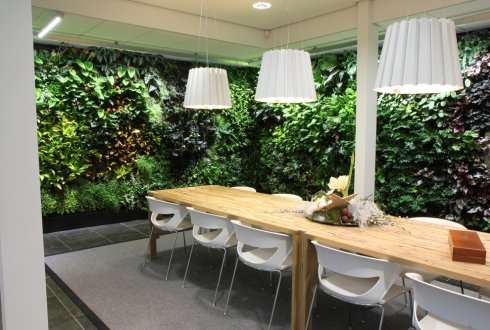Interior climate effects of plants in offices and care institutions

The interior climate of many buildings is poor. This is also the case for offices, schools, hospitals, and other public and semi-public buildings. Small-scale research suggests that plants can make a significant contribution to the resolution of problems in interior climates. A group of research institutes, social organisations and companies is now set to perform large-scale research into this. Companies and care institutes wishing to participate can register.
Plants add moisture to the air, can help purify the air of undesired substances and also create a pleasant environment. All these factors can also deliver cost savings, both from a technical perspective (reduced need for artificial climate control, energy savings, etc.) and from the perspective of the improved performance of the users of the building (for instance expressed in lower rates of sickness absenteeism). So why has there not yet been a large-scale introduction of plants in buildings?
"Because there are as yet insufficient concrete figures on the matter and insufficient innovative and usable green solutions," explains project leader Annemieke Smit of Alterra. "There is a lack of awareness and hard evidence of the economic effects achieved through cost savings on the technical side and improvements for the user. In other words, no cost-benefit analysis has been carried out on which companies and institutions can base their policies and actions if they want to make the interiors of their premises greener."
The research should lead to an improved use of greenery in buildings for a more sustainable set-up and a healthier living and working climate. The research that has been performed so far has generally been of too small a scale, too fragmented or carried out under laboratory conditions. A new innovation project will not only look at what plants physically contribute to the air quality in buildings, but also the influence of this on the health and well-being of the people working or living there. In this way, the researchers want to examine the actual effects of the large-scale use of plants on the interior climate. As part of this, attention will also be devoted to the costs and benefits of this. For instance, can savings be made with regard to the traditional, energy-wasting air treatment systems? Can plants reduce sickness absenteeism, or boost people's powers of concentration and therefore also their productivity?
The study forms part of De Groene Agenda (The Green Agenda), an overarching programme for a healthy living and working environment, thanks to a grant from the Horticulture & Propagation Materials top sector, and will be carried out by a large consortium of institutions and companies, including Alterra Wageningen UR, Fytagoras, Wageningen University, the IVN, the Dutch Green Building Council, the iVerde foundation, FloraHolland, Noviflora, Donkergroen and Priva.
"We are now just looking for companies and health-care institutions that would like to participate; in other words, practical locations at which we can carry out the research," says Annemieke Smit. "Interested parties can contact us."
Provided by Wageningen University


















